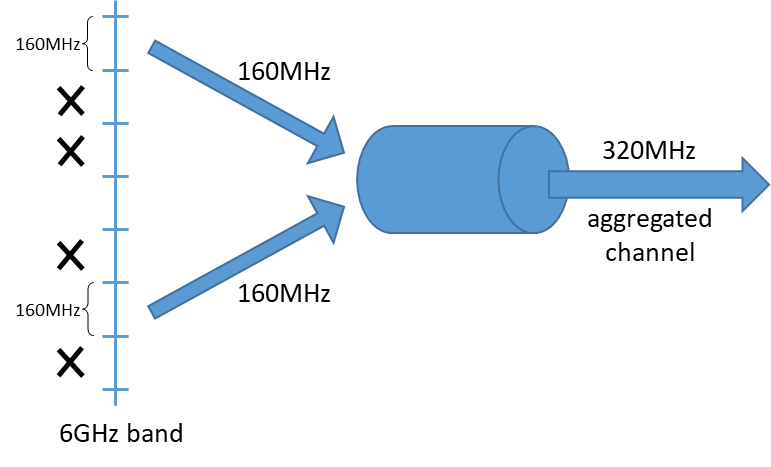Understanding Wi-Fi Design Choices: Wi-Fi 6/6E vs. Wi-Fi 7 and MLO
Learn the optimal Wi-Fi version, flavor and configuration to select for your application—considering feature sets, costs, and power consumption. Get up to speed on MIMO, MU-MIMO, MU-OFDMA, and more.
Since the establishment of the Wi-Fi Alliance in 1999, Wi-Fi technology has consistently advanced to meet the ever-increasing demand for faster speeds and support for a greater number of devices. Its popularity has grown to the extent that it has become a common term in the dictionary.
Today, it serves as the ubiquitous internet connection for a diverse array of clients, ranging from data-hungry devices such as laptops, smartphones, TVs, and set-top boxes, to data-tweeting IoT gadgets that send out occasional updates, like home and office appliances.
Wi-Fi Device Market on the Rise
According to market research firm ABI, annual Wi-Fi enabled device shipments are on a continual rise and are projected to surpass 5 billion units by 2028, with the primary driving force for future growth expected to come from the Smart/Connected Home, Wearable and IoT market segments.
Wi-Fi technology today exists in many kinds of flavors and configurations, supporting hundreds of features with various levels of complexity. It may be challenging for a device maker to select the right specification that fulfills the functionality, performance, cost, and power consumption constraints. In this article, we’ll share insight on the important parameters to consider to determine the best choice.
What is Wi-Fi 6?
Derived from the IEEE 802.11ax standard, it is the most popular generation currently used on the market. According to ABI, almost half of Wi-Fi devices shipping in 2023 will be WI-FI 6, and this will climb to two thirds of shipments by 2026.
Compared to WI-FI 5 (IEEE 802.11ac), WI-FI 6 comes with double the maximum MIMO configuration, double the maximum channel bandwidth and a higher modulation scheme. This translates to more than 5 times the maximum data rate at PHY level. Even though that is quite significant, this is not what has made WI-FI 6 so popular, with the fastest penetration rate ever for a new generation.
The main benefit of WI-FI 6 is higher network efficiency, particularly in dense areas where more devices can be connected to the same access points, delivering a better user experience with higher throughput and lower latency. This higher efficiency is coming from two major features, among others. Let’s look at Multi-User MIMO and Multi-User OFDMA.
Multi-user MIMO (MU-MIMO):
This divides the MIMO operation of an Access Point (AP) between multiple users (or stations). For instance, an 8x8 AP can handle up to eight 1x1 users simultaneously, one per spatial stream. The AP sends a single 8x8 MIMO packet over the air (downlink) containing data for each user on its respective allocated spatial stream. Each user can reply (uplink) simultaneously on its respective spatial stream. MU-MIMO downlink was already supported in Wi-Fi 5 Wave 2, while MU-MIMO uplink was not.

Figure 1. The Wi-Fi 6 MU-MIMO feature increases significantly the network efficiency by filling the spatial streams and parallelizing the data traffics as much as possible.
Multi-user OFDMA (MU-OFDMA)
This allows the total available bandwidth to be divided among several users into what is called Resource Units (RU). This way, more users can be connected to the AP. For instance, up to 37 simultaneous users can share an 80MHz channel, each using just 2MHz bandwidth. Furthermore, such narrow band allows better coexistence with other narrow band technologies such as Bluetooth and 802.15.4 (i.e., Thread, ZigBee).

Figure 2. The Wi-Fi 6 MU-OFDMA feature increases significantly the network efficiency by sharing the channel bandwidth (here the truck) among several users.
MU-MIMO and MU-OFDMA enable an AP to better schedule traffic among users, with proper granularity and better control on Quality of Service. Hundreds or even thousands of devices can be connected to the AP with limited congestion. Moreover, the slower WI-FI 6 IoT devices can seamlessly coexist with WI-FI 6 high demanding devices without impacting their throughput and latency.
Another great feature of WI-FI 6 is Target Wake Time (TWT). It is particularly interesting for low power IoT devices: each WI-FI 6 device connected to the AP can go into deep sleep and wake up at its respective scheduled time pre-negotiated with the AP. This minimizes conflicts and significantly reduces the power consumption.
What is Wi-Fi 6E?
WI-FI 6 operates on the 2.4 GHz and 5 GHz bands. The 2.4 GHz band is notoriously crowded with other wireless technologies such as Bluetooth, Zigbee and Thread. The 5 GHz band is the express highway to avoid this congestion.
All that said, the demand for data bandwidth is never satisfied. There are now many more video streaming services offering higher resolution video. In many parts of the urban world, fiber-to-the-home is being rolled out, offering the potential of super-fast internet which then needs to be served out within the home/office.
The recent surge in working from home during the covid 19 pandemic also increased the appetite for reliable, high-speed Wi-Fi. The capacity of even the 5 GHz express highway of WI-FI 6 is being stretched. So WI-FI 6E (still derived from IEEE 802.11ax standard) has been released to expand the capacity using the 6 GHz band (more precisely, from 5.925 GHz to 7.125 GHz).
This extra 1.2 GHz bandwidth adds up to 7 channels of 160 MHz bandwidth (whereas only 2 such wide channels are available on the 5 GHz band), or up to 14 channels of 80 MHz bandwidth (only 5 are available on the 5 GHz band).
Despite the geographical challenges around the 6 GHz spectrum (not all the 6 GHz bandwidth is available worldwide, as described on the Wi-Fi Alliance website), WI-FI 6E is proving to be very popular, creating some much-needed breathing room in the relentless search for data bandwidth.
This extra 6 GHz band comes with lower congestion, hence offering better quality of service with lower latency. This is particularly important for gaming and AR/VR headset applications. However, it has a more limited range with reduced wall and ceiling penetration capability.
What is Wi-Fi 7?
While WI-FI 7 is still to be ratified later in 2024, we have already started to find “pre” WI-FI 7 chips and devices on the market. Originated from the IEEE 802.11be specifications, WI-FI 7 will come with bigger muscles. These include:
- Up to 320 MHz channel bandwidth, compared to 160 MHz in WI-FI 6/6E (802.11ax). This is available only on the 6 GHz band.
- Up to 16x16 MIMO configuration, compared to 8x8 in WI-FI 6/6E (802.11ax)
- 4K QAM maximum modulation, compared to 1K QAM in WI-FI 6/6E (802.11ax)
WI-FI 7 is almost 5 times faster than WI-FI 6/6E. But this is not the only reason for the sudden appetite for WI-FI 7. Two very important features are driving attention to this next Wi-Fi generation: Multi Link Operation (MLO) and Multi Resource Unit (MRU).
Multi Link Operation (MLO)
This provides the ability to aggregate two channels from the same or different bands in order to increase the throughput, stepping around interference and reducing latency. For example, it may be very challenging or even impossible to get a free 320 MHz channel on the 6 GHz bands, among the 3 such channels available, because of interferers.
To overcome this situation, thanks to MLO, a WI-FI 7 (802.11be) connection may aggregate two disjointed 160 MHz channels in the 6 GHz band, from the 7 channels available, or one channel on the 6 GHz band with another one on the 5 GHz band. Any combination is theoretically possible, including for instance aggregation of 160 MHz + 80 MHz channels on the 5/6 GHz bands.

Figure 3. The Wi-Fi 7 Multi Link Operation (MLO) feature allows two links (or channels) to be aggregated to increase the overall throughput. Here two 160 MHz bandwidth channels are aggregated.
MLO can also be used for load balancing, by quickly and seamlessly switching between channels to minimize contentions/retries. This also translates into a reduction of the latency.
Multi Resource Unit (MRU)
When there is a need for a “large” resource unit driven by the user's throughput requirement, such a large bandwidth may not be free throughout the whole channel bandwidth. So, with a similar concept to MLO, but on the same channel, two contiguous or disjointed Resource Units may be aggregated for a single user to achieve the throughput requirement.
Thanks to MLO and MRU, WI-FI 7 (802.11be) is very attractive, particularly in applications with high throughput, low latency and high link reliability requirements. How, when and which channels to aggregate is where the WI-FI 7 infrastructure providers will differentiate.
Other Design Configuration Parameters
Knowing the benefits brought by each technology generation, what is the best one for my application? On top of the generation and related feature set, one also needs to consider the maximum supported configuration parameters. Let’s look at each of these.
Supported Radio Frequency Band
The default is 2.4 GHz, supported in all flavors. As the 2.4 GHz spectrum is crowded, with many technologies competing to get the medium (Wi-Fi, Bluetooth, Zigbee, other proprietary technologies), it can be interesting to also support the 5 GHz band or even 6 GHz band (on WI-FI 6E and WI-FI 7).
This comes as an additional cost—extra die size on the chip for the 5/6 GHz radio—but can help to reach higher throughput and shorter latency thanks to lower congestion and less retransmission.
Maximum Signal Bandwidth
The signal bandwidth can be 20 MHz, 40 MHz, 80 MHz (starting from Wi-Fi 5 / 802.11ac), 160 MHz (starting from WI-FI 6 / 802.11ax) or 320 MHz (WI-FI 7 / 802.11be on the 6 GHz band only).
The larger the signal bandwidth, the higher the data throughput. If high throughput is not an important parameter, it can nonetheless be beneficial to support a larger bandwidth. For a given throughput, a larger bandwidth leads to shorter time spent over the air, hence lower power consumption.
Moreover, less time spent over the air leaves more empty space for others, so more devices can coexist. This is why many low power IoT devices support up to 40 MHz bandwidth instead of just 20 MHz, even if it comes at a small extra cost.
Maximum MIMO Configuration
A Wi-Fi system can have single transceiver chain (SISO, aka Single Input Single Output) or multiple transceiver chains (MIMO, aka Multiple Input Multiple Output). Any combination of numbers of transmit and receive chains is actually possible, up to the maximum authorized by the standard. For example, up to 8x8 with WI-FI 6, up to 16x16 with WI-FI 7. 1x1 refers to a SISO configuration, while 2x2 is a MIMO system with 2 transmit and 2 receive chains.
Asymmetric configurations also exist such as for instance 2x3 which has 2 transmit chains and 3 receive chains. More chains mean higher throughput. It is like having several pipes in parallel. For example, 2x2 is up to twice faster than 1x1. But sometimes an increase of the number of chains is not intended to increase the throughput but to reach higher sensitivity thanks to extra diversity.
For instance, a 2x3 configuration may just support 2 (instead of 3) spatial streams on the receive side, the third chain being used to get extra signal diversity hence more dB of sensitivity. To summarize, more chains mean more throughput or higher sensitivity, but comes with extra die size and cost due to the duplication of radio chains.
Maximum Modulation Coding Scheme (MCS)
The maximum throughput that can be achieved on a transceiver chain also depends on the highest Modulation Coding Scheme (MCS) supported. But a higher MCS leads to more complex signal processing in the modem and more stringent requirements on the analogue/radio architecture, which translates to bigger die size and higher power consumption.
This is the reason why sometimes WI-FI 6 low power IoT solutions only support MCS8/9 (256QAM) in order to save cost and power consumption, while the WI-FI 6 standard can support up to MCS10/11 (1024QAM).
Multi radio / Multi Link Configuration
When a device supports multiple bands (2.4 GHz, 5 GHz and sometimes 6 GHz), links on the various bands can be handled with a single instantiation or several instantiations of Wi-Fi system:
- A single instantiation allows to handle each band simultaneously but with time division. This is transparent from the user/application point of view except that the total throughput is shared between each band. A single instantiation anyway enables the support of Wi-Fi 7 Multi Link Single Radio (MLSR) feature which allows to instantly switch from one channel to another for higher reliability and shorter latency.
- Multiple instantiations allow it to support several bands fully concurrently, hence supporting higher aggregated throughput. This comes at a higher cost due to bigger die size but can be compensated by the additional value it brings.
How to Choose the Best Choice for Your Application
So, what is the best version and configuration for your application? It is not always appropriate to select the latest and greatest flavor and configuration as this could lead to an expensive overkill. The challenge is to select the flavor and configuration that provides the best compromise between performance, cost and power consumption. Let’s have a look at a few examples.
Low Power IoT Devices
What often prevails in low power IoT is cost, then power consumption. This is why WI-FI 4 (derived from IEEE 802.11n specification) single band 2.4 GHz is still dominant, as one can find chips far below $1 that are good enough. But as volumes are picking up, the WI-FI 6 chip cost is quickly getting very close to WI-FI 4 chips. It also brings additional benefits:
- Higher data throughput if required: WI-FI 4 1x1 40 MHz bandwidth can go up to 150 Mbps PHY data rate when using MCS7 (64QAM modulation) while WI-FI 6 1x1 40 MHz bandwidth
- Lower power consumption thanks to TWT feature. Less conflicts leads to less retransmission, hence less time spent over the air.
- Lower power consumption thanks to higher data rates. For a given data throughput, higher data rate means less time spent over the air, hence lower power consumption as the radio is enabled during a shorter period of time.
- More WI-FI 6 devices can connect to a WI-FI 6 access point.
- Low power IoT devices are usually slow. Unlike with previous generations, WI-FI 6 slow devices do not slow down the Wi-Fi network and so better co-exist with fast devices.
If reliability is a critical parameter, it is important to at least support dual band. This is usually the case in some industrial applications.
If latency is critical, it is a must to support Wi-Fi 7 with two or three bands. This may be the case in some industrial and medical applications.
High End Devices
High end Wi-Fi enabled devices are usually dealing with high volume data transfer such as video streaming and file sharing. These devices include smartphones, tablets, PC/laptops, TV, STB, camera, AR/VR headset, etc. They predominantly have MIMO 2x2 multi-band configuration.
While we still see a lot of Wi-Fi 5 chips on the market, new designs are predominantly at least Wi-Fi 6 (802.11ax) in order to get the benefits of the throughput efficiency, particularly as the number of devices connected to the access point is growing. Some of them such as smartphones, gaming consoles and AR/VR headset will see great benefits in moving to Wi-Fi 6E or even Wi-Fi 7 (802.11be) to enjoy even higher reliability and lower latency.
Access Points
When designing/deploying/upgrading an infrastructure, it is recommended to go for Wi-Fi 7 (802.11be) access points, particularly in dense environments such as airports, stadium, shopping centers and offices, where up to thousands of users are connected, moving, and having dynamic Wi-Fi requirements, regularly switching between emailing, browsing, chat, file transfer and video conferencing. These access points usually have 4x4 MIMO configuration or above.
For smaller environments such as home or small offices, access points with 2x2 MIMO configurations are usually enough. According to ABI, 2x2 configuration represents more than 40% of the total networking and access point Wi-Fi chipset shipments. If there is no very strong latency requirement, Wi-Fi 6 or 6E can be enough from a technical point of view, but the marketing value of WI-FI 7 in relation to competition must be considered.
Industry Articles are a form of content that allows industry partners to share useful news, messages, and technology with All About Circuits readers in a way editorial content is not well suited to. All Industry Articles are subject to strict editorial guidelines with the intention of offering readers useful news, technical expertise, or stories. The viewpoints and opinions expressed in Industry Articles are those of the partner and not necessarily those of All About Circuits or its writers.







